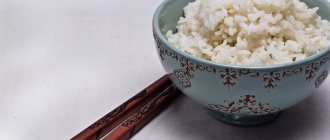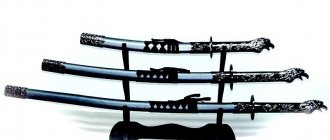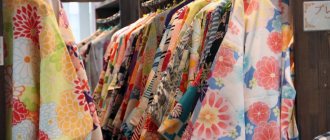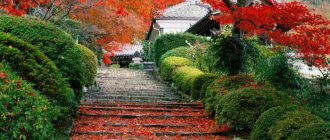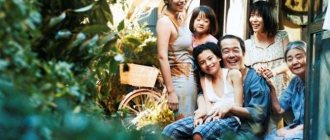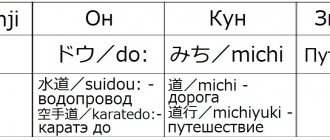The Japanese bath has little in common with traditional European baths and saunas.
The process of ablution in the countries of the East belongs to completely different cultural traditions, the history of which goes back many centuries. This is not just a hygienic procedure - it is a ritual designed to preserve the health, beauty and youth of the body, as well as inner spiritual harmony and tranquility.
What is it - a Japanese bath
A Japanese bathhouse is a spacious room with good ventilation and a flow of fresh air. There is no steam room, sink, brooms or other bath paraphernalia. Instead, the room contains a large wooden container, called a furaco, and a couch for relaxing.
The main purpose of a Japanese bath is to relax the body and mind, take a break from worries and tune in to peace.
Features of Japanese baths
The Japanese sauna is fundamentally different in that it uses not hot steam or air, as in the vast majority of baths and saunas, but heated water. The prerequisites for the emergence of such hygiene procedures are the following factors:
- The predominant religion in Japan is Buddhism, which prohibited the use of soap, because at that time it was made from the fatty tissue of killed animals. But it is impossible to effectively wash off impurities from the skin without soap, so they began to use hotter water. For an unaccustomed European, the water temperature in a Japanese sauna is almost unbearable.
- Religious views prohibited wearing clothes made from wool and fur. Light cotton fabrics are not able to warm the body.
- The climatic conditions on the Japanese islands are quite harsh. It is always humid and damp, and in winter temperatures drop below 0° C. Traditional homes always had thin walls and were cold. To keep warm and not get sick from hypothermia, they used a unique Japanese sauna in the form of a container with hot water.
- Since ancient times, the Japanese have used thermal springs for these purposes, of which there are a large number throughout the country. But not everyone could get there freely, since they were not always located close to home. As an alternative, a barrel of very hot water was used.
Nowadays the Japanese use various cosmetics, and this kind of bathhouse is more of a healing nature, since it strengthens the immune system, strengthens the body, improves metabolic processes, increases efficiency and lifts the mood.
Mixed baths in Japan that every foreigner dreams of visiting
Japan is a unique country, and many of its traditions are incomprehensible to foreigners. However, there are also those that visitors admire - for example, the age-old procedure of skinny dipping in thermal springs.
Japan is famous for its bath traditions. People swim here a lot and willingly. In addition to the usual hygienic shower, the Japanese love to soak in the hot water of thermal springs, which are found in abundance here.
Usually near such a place there are hotels, campsites and various types of services are offered. The infrastructure is very developed.
You can come here for a few hours to soak in the healing water, rich in micro- and macroelements, or improve your health by immersing yourself in a leisurely relaxation for the whole weekend.
These baths are called onsens. They can be external or internal, located in a hotel or spa complex.
The water in the springs varies in composition. For example, in Nagayu Onsen on the island of Kyushu, the water is saturated with sodium and magnesium salts. Thanks to the super-strong concentration of CO2, when immersed in the source, the body is covered with gas bubbles, which penetrate the body through the skin, expanding capillaries and improving blood circulation. Thanks to this effect, lovers of geothermal procedures feel a constant rush of heat and do not freeze when leaving the bath.
Interestingly, some onsens still practice mixed relaxation - men and women bathe in the same source. However, let’s make a reservation right away: there are not many such places left in the country. Modern onsens most often have two sections - for men and women. And only children can be in both places, and even run from one bath to another while their parents are taking water procedures. But even in this case, such behavior is encouraged up to a certain age.
Originally, onsens were used for skinny-dipping. This is understandable - in this state the skin breathes, better absorbs minerals dissolved in water, and the sensations are of a completely different order than when swimming in clothes.
However, with the advent of tourism in the country, foreigners began to become interested in local traditions and got their hands on bathing in the springs.
As often happens, the Japanese were forced to follow the lead of morality and now there are almost no naked bathers to be found (if it weren’t for Instagram and the girls who love to arrange photo shoots, we wouldn’t see what the bathers look like in these hot springs!).
Baths, where visitors are naked in the spring, have survived only in small towns and remote villages.
The general rule for visiting an onsen is to first take a hygienic shower and enter the bathhouse clean.
If the rules of the establishment require you to be dressed in the bathhouse, you must take at least a towel with you - after wrapping yourself in it, you can go into the source.
The Japanese are also demanding when it comes to tattoos on their bodies. Only in half of the baths will they not pay attention to “painted” visitors, in the rest they treat tattooed ones with caution - this is due to years of fear of the yakuza. The more provincial the onsen, the fewer complaints about the presence of clothing on bathers and the greater the hostility towards tattoos. In the best case, in a remote village, a “downtrodden” guy or girl will be told to cover the pictures on his body with a plaster or swim in his clothes; in the worst case, they may be refused entry.
Hot springs are a traditional way for the Japanese to improve their health. It has been proven that bathing in the thermal waters of an onsen strengthens the walls of blood vessels, treats skin diseases and is useful for neuralgia.
In addition, being in mineralized water calms the nervous system, relaxes and relieves stress. For those who still want to see an authentic onsen with a mixed bath, the Japanese recommend going to the province. There you will relieve stress and become 100% healthier.
Sequence of procedures in a Japanese bath
In Japanese bath traditions, the sequence of treatments is extremely important. Each step must have a corresponding effect, without which it is impossible to proceed with subsequent steps.
In a Japanese bath, you must go through the following steps in sequence:
- Take a shower.
- Steam and warm up your feet in a special bath.
- Then a foot massage is performed. This stage is preparatory. During the massage, biologically active points are activated, of which there are a large number on the feet. The result of this procedure is an appropriate mood for relaxation and relaxation.
- Immerse yourself chest-deep in a furaco - a barrel filled with water at a temperature of +35...+45° C, for 10-15 minutes. Warm water should not reach the heart line, as this will cause unnecessary stress and poor health.
- Get out of the barrel, wrap yourself in a towel and lie down on the couch to rest.
- Now start taking dry baths. First, they are immersed in ofuro - a container filled with sawdust heated to +45...+50°C for 10-15 minutes.
- Take a shower again to wash away any remaining sawdust.
- This is followed by ofuro with stones, which are heated to +50…+60° C.
- The last and final stage is the tea ceremony.
For bathing in Japan, special barrels and bathtubs made of coniferous wood are used.
Baths and saunas in Japan
As you know, Japan is a country with its own traditions and customs, all of which are quite interesting and multifaceted.
To a foreigner, in turn, many things may seem incomprehensible, but in fact there is nothing difficult in figuring out what this or that sphere is like in the Land of the Rising Sun. Now I would like to talk about baths and saunas, because Japan also has something similar, albeit in a slightly different form. To be more precise, there is a certain symbiosis of a bathhouse and a sauna, which is called sento (if we are talking, of course, about public baths).
This establishment is somewhat different from the traditional Russian bathhouse and Finnish sauna, since completely different traditions take place here. For example, the steam room that we all are used to is absent as a class, but instead the visitor is rubbed with a washcloth, a vat of water is poured on him, and after that the person plunges into a special wooden bath. There you can bask and relax, and the process itself is considered very beneficial for health.
Sento is an almost sacred place for the Japanese. People go here with friends and work colleagues to relax after a hard day, and on weekends the whole family visits the bathhouse, as it is believed that this is a wonderful vacation and you can calmly enjoy the company of the people closest to you.
With all this, the Japanese never eat in the bathhouse, unlike our fellow citizens who are used to coming there with full bags of food and alcohol. The Japanese usually don’t even drink tea in baths, and the most they can afford is a small bottle of mineral water. Residents of the Land of the Rising Sun believe that eating food at high temperatures is very harmful to health and there is definitely logic in their words.
Visiting Japanese baths is very useful and, if you have such an opportunity, never refuse it. By the way, try to follow certain rules, because the Japanese have traditions and failure to comply with them can cause offense. For example, at the entrance to the bathhouse you will be given a package and you must accept it; there is usually a towel and soap there. Once again, be sure to take off your shoes at the entrance. They enter the bathhouse barefoot and immediately find themselves in the locker room, from where there are already two entrances, one leading to the men's part of the bathhouse, and the other to the women's, respectively.
After you have completed several procedures and are about to get out of the bathroom, you should not dry yourself immediately. The mineral water should be absorbed into the body, so simply throw on a robe and lie down on the couch to relax.
<School skirt
Contemporary fashion from young Japanese designers>
Japanese bath furako
The key attribute of the Japanese bath is the furako barrel, which is a large round (sometimes oval) container made of valuable wood (cedar, oak, etc.). The container is equipped with a stove for heating water. Furaco options for the home are equipped with gas or electric stoves. For an outdoor barrel, a wood stove is more suitable. Traditional Japanese baths have always been heated with wood.
The Japanese barrel sauna is divided from the inside by a lattice wooden partition. In one compartment the bathing procedure is carried out, the other is intended to accommodate a heating device. In some designs this device may be external. The ablution compartment is equipped with a wooden bench around the entire perimeter for comfortable seating for visitors. The furaco font with a stove can accommodate from 2 to 8 people.
The water is heated to +35...+45° C, to enhance the positive healing effect, incense, aromatic oils, herbal decoctions and infusions, flower petals, etc. are added to it. The very material of the barrel from which it is made releases phytoncides into the hot water. These substances have a positive effect on the human body, providing tonic and restorative effects.
The beneficial effects of the Japanese barrel of furaco are the following:
- with sweat secretions, a large amount of waste and harmful toxins are removed from the body;
- metabolic processes and the functioning of the immune system are stimulated;
- the condition of the skin improves, pores open;
- the activity of the heart and blood vessels is normalized;
- helps in the prevention and treatment of diseases of the genitourinary system, musculoskeletal system and respiratory tract diseases.
The design of the Japanese barrel bath includes a lid with which it is closed in the absence of visitors and to protect it from unwanted debris (in the street version).
Japanese bath ofuro
A Japanese bath can be made in the form of a rectangular box. For production, specially processed cedar, teak, ash or oak wood is used. This container has thick walls and is equipped with a heating system, which is located in its bottom. Heating systems are equipped with various additional options - thermostat, remote control, etc. The size of the box varies, depending on the number of people it can accommodate. More often, such a bath is intended for one visitor. He lies down in it at full length.
The ofuro font is filled with sawdust (larch, cedar, linden, oak) mixed with dry leaves, medicinal herbs (more than 60 types), roots and aromatic essential oils. The mixture is heated to +45...+50° C. The weight of sawdust is about 45-50 kg, the top layer (about 2 kg) is removed and renewed after each visit to the bath.
They are immersed in the sawdust bath up to their necks and remain there for no more than 30 minutes. During this time, the skin warms up well. Increased sweating begins, during which toxins are released from the body. The sweat is immediately absorbed by the sawdust.
At the same time, the heated sawdust itself releases beneficial oils and volatile substances that have a healing effect on the skin (destroy germs and bacteria, heal wounds, relieve irritation, etc.). Aromatic components activate metabolic processes and slow down aging. Ofuro bath is considered the best remedy for rejuvenation and weight loss.
After visiting a bath with sawdust, you are supposed to undergo a similar procedure in a box with dry pebbles heated to 60°C, covered with a sheet or towel. They lay on it with their back and lie for 10-15 minutes. You can lie on your stomach, in which case heated stones are additionally placed on your back along the spine. There are options for the ofuro bathhouse in volcanic ash.
Japanese sento bath
Japanese public baths, sento, are very popular. Such a bathhouse is a fairly spacious and well-ventilated room, which houses a spacious but shallow pool with hot water (+50...+55° C). The size of the pool varies, sometimes it can accommodate up to 100 people. There are always 2 sections in a sento: women's and men's. The premises for women are more spacious and have many mirrors.
First, remove all clothing in a room equipped with separate booths. Afterwards, you should thoroughly wash your body using various hygiene products (soap, shampoo, washcloths, etc.). A special washing room is designed for this purpose. There they wash themselves under the tap, sitting on a low bench. In Japanese traditions, it is customary to wash using a contrast shower.
Only after this can you dive into the hot water of the pool. The time spent in the pool is no more than 10-15 minutes; staying there longer is harmful to the body. The Japanese bathhouse has special relaxation rooms where you can lie down after taking hot treatments. Tea drinking is the traditional end of the bath ceremony.
Initially, sento baths were intended and built only for priests; they looked rather unpresentable and ascetic. But gradually the baths became available to the rest of the population. The premises began to be decorated with paintings on the walls (waterfalls, volcanoes, cherry blossoms, etc.), which invite contemplation and reflection.
How not to embarrass yourself in Japanese baths
There is nothing more relaxing than soaking in the warm water of a Japanese hot spring. But as you prepare for your bath, you should be aware of the ins and outs of public bathing in Japan. Besides leaving your rubber ducky at home, here are 9 key tips for ensuring you have the best time of your life, without having to hear someone grumble in Japanese about the "lack of proper bathing manners among young people these days." .
Whether you're heading to a real hot spring or a public bathhouse, here are nine things to keep in mind before entering the world of Japanese bathing.
Sentō (銭湯) is a type of Japanese communal bathhouse where customers pay an entrance fee. Traditionally, these baths were quite utilitarian, with a high barrier separating men and women in one large room. The bathing area is separated from the changing area by a sliding door to keep the bath warm. The baths are equipped with stools, taps, wooden buckets and toiletries such as soap and shampoo, the attendants usually sell these items for 100-200 yen, almost all of them are also equipped with removable shower heads. Since the second half of the 20th century, the number of these public baths has been declining as more and more Japanese homes now have their own baths.
Onsen (温泉) is a Japanese hot spring; the term also extends to bathing facilities and traditional inns, often located around hot springs. As a volcanically active country, Japan has thousands of onsens scattered throughout its main islands.
An onsen, by definition, uses naturally hot water from geothermal springs. This is the main difference between Onsens and SENTO, indoor public baths where the baths are filled with heated tap water.
Onsens come in many types and shapes, including outdoor (露天風呂 or 野天風呂roten-buro or noten-buro) and indoor (湯湯uchiyu) baths. Baths may be publicly run by a municipality or privately owned, often as part of a hotel, ryokan, or restaurant (民宿minshuku).
Traditionally, men and women bathed together in both onsen and sento, but gender separation was introduced since the opening of Japan to the West during the Meiji Restoration. This practice contributed to Western views of the Japanese as an inferior race at the time. Mixed bathing (混浴 kon'Yoku) persists in some special onsen in rural Japan, which usually also provide the option of separate "ladies'" baths or different hours for the two sexes. Men may cover their genitals with a small towel when out of the water, while women usually wrap their bodies in full-sized towels. Children of any gender may be seen in both men's and women's baths. In some prefectures in Japan, including Tokyo, where mixed nude bathing is prohibited, people are required to wear swimsuits or yugi (湯着 yugi), or yuami-gi, which are specifically designed for swimming
CONTENT
Be prepared for nudity
Leave your bathing suit at home because covering up will only make you look weird. While some places may allow this, most places completely prohibit anything other than a "birthday" costume. Some say it's because swimsuits "distract" from the peaceful feeling of swimming. Regardless of the reason, place all your clothes in a hamper or locker in your locker room. However, unlike sento, it is generally accepted to use a towel or hand to cover your modesty when visiting onsen baths, at least for entering and exiting the water. If conditions do not allow placing a towel somewhere on the shore, it is placed on the head.
▼Bathers are generally not allowed to wear swimsuits in bathtubs. However, some modern onsens with a water park atmosphere require their guests to wear a swimsuit in mixed baths.
Keep in mind that some young children may share the bath with their parents. Therefore, do not be surprised if a little boy runs around the women's baths and vice versa.
The main thing is health
Between the sleep-inducing warm water, slippery surfaces and lots of naked people, losing your health is an easy task. As funny as it may sound, save yourself a trip to the hospital, jail, or just embarrassment and don't drink too much sake before swimming.
Also, you should eat something to avoid swimming on an empty stomach. If you have any health problems, such as high blood pressure or early pregnancy, it is best to talk to your doctor before taking a long hot bath. Additionally, in recent years, onsens have increasingly added chlorine to their waters to prevent infection, although many onsen purists are looking for natural, non-chlorinated onsens whose management does not recycle the water but instead cleans the baths daily.
3. Hair
Sentō usually displays a poster describing bathing etiquette and procedures in Japanese or sometimes other languages for foreign clients. There are few things that are so indescribably disturbing while enjoying a peaceful soak in the bath, like long tufts of hair floating from a stranger. There are usually noise restrictions in washing and bathing areas; However, a small amount of excess energy and splashing usually comes from children.
▼ Bring hair ties.
Shower before swimming
It sounds counterintuitive, but the Japanese custom of showering before taking a bath makes a lot of sense when you think about the number of naked bodies of people with whom you share the same water. The bathtub itself is intended for soaking only, so save the washcloth for the wash stations and shower stalls, and be sure to scrub every inch and rinse off all the soap before heading into the hot water pool.
5. Towel
Japan takes nudity seriously. Feel free to use a towel to cover your household as you walk from the shower to the bath, but try not to let it touch the bath water. Although it may be clean, others may think you are rinsing a dirty towel in public water.
Don't splash or swim
The Japanese public bath is one area where the uninitiated can frustrate regulars by not following proper bathing etiquette. You are not a child, and the baths are not the place to prepare for the Tokyo 2021 Olympic Games. The whole idea of going to a bathhouse is to relax and enjoy the calm, peaceful atmosphere, sometimes with the sound of music or a fountain, so just sit there in silence.
Don't change the water temperature
Since the water comes from natural mineral springs, in one or more pools, the water can be surprisingly hot. Instead of adjusting the temperature yourself by adding cold water, wait until your body slowly acclimates to the warmth. Many people visit these baths only because of the high temperatures and would be very disappointed if the water suddenly turned cool. If you feel like you're getting too warm or uncomfortable, move up to a higher level in the bath (if possible) so that less of your body is submerged. Dip back down when you're ready to warm up again.
Don't go into the locker room wet
When you're ready to leave the swim area and return to the world of clothing, try to dry yourself off as much as possible before entering the changing room. This is what your towel (that you didn't put in the water ) is used for.
Tattoo ban
The most surprising rule in Japanese baths for many foreigners is the outright ban on clients with tattoos. Apparently this is because many Japanese people cannot separate tattoos from Japanese history. During the Edo period (1603-1868), the punishment for non-violent crimes was a tattoo directly in the center of the offender's forehead. By 2015, about half (56%) of onsen operators banned bathers with tattoos from using their services. The original reason for banning tattoos was to keep out the Yakuza and members of other criminal gangs who traditionally made full body jewelry.
▼ Don't waste your time, guys - swim at home
Baths aren't the only places; many gyms, swimming pools and saunas also prohibit people with tattoos from entering. Some are particularly harsh and bold, even prohibiting the use of cosmetics or bandages that hide small tattoos. They might even cancel your membership if they find out! Although, in many places they will close their eyes if you make some effort to hide them.
Views: 2,228
Share link:
- Tweet
- Share posts on Tumblr
- Telegram
- More
- by email
- Seal
Liked this:
Like

